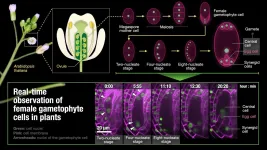Scientists turn to deep learning to improve air quality forecasts
2021-04-02
(Press-News.org) Air pollution from the burning of fossil fuels impacts human health but predicting pollution levels at a given time and place remains challenging, according to a team of scientists who are turning to deep learning to improve air quality estimates. Results of the team's study could be helpful for modelers examining how economic factors like industrial productivity and health factors like hospitalizations change with pollution levels.
"Air quality is one of the major issues within an urban area that affects people's lives," said Manzhu Yu, assistant professor of geography at Penn State. "Yet existing observations are not adequate to provide comprehensive information that may help vulnerable populations to plan ahead."
Satellite and ground-based observations each measure air pollution, but they are limited, the scientists said. Satellites, for instance, may pass a given location at the same time each day and miss how emissions vary at different hours. Ground-based weather stations continuously collect data but only in a limited number of locations.
To address this, the scientists used deep learning, a type of machine learning, to analyze the relationship between satellite and ground-based observations of nitrogen dioxide in the greater Los Angeles area. Nitrogen dioxide is largely associated with emissions from traffic and power plants, the scientists said.
"The problem right now is nitrogen dioxide varies a lot during the day," Yu said. "But we haven't had an hourly, sub-urban scale product available to track air pollution. By comparing surface level and satellite observations, we can actually produce estimates with higher spatial and temporal resolution."
The learned relationship allowed the researchers to take daily satellite observations and create hourly estimates of atmospheric nitrogen dioxide in roughly 3-mile grids, the scientists said. They recently reported their findings in the journal Science of the Total Environment.
"The challenge here is whether we can find a linkage between measurements from earth's surface and satellite observations of the troposphere, which are actually far away from each other. That's where deep learning comes in."
Deep learning algorithms operate much like the human brain and feature multiple layers of artificial neurons for processing data and creating patterns. The system learns and trains itself based on connections it finds within large amounts of data, the scientists said.
The scientists tested two deep-learning algorithms and found the one that compared the ground-based observations directly to the satellite observations more accurately predicted nitrogen dioxide levels. Adding information like meteorological data, elevation and the locations of the ground-based stations and major roads and power plants improved the prediction accuracy further.
Yu said the study could be repeated for other greenhouse gases and applied to different cities or on regional and continental scales, the scientists said. In addition, the model could be updated when new, higher-resolution satellites are launched.
"With a high spatiotemporal resolution, our results will facilitate the study between air quality and health issues and improve the understanding of the dynamic evolution of airborne pollutants," Yu said.
INFORMATION:
Also contributing to this study was Qian Liu, a doctoral student at the National Science Foundation Spatiotemporal Innovation Center at George Mason University.
ELSE PRESS RELEASES FROM THIS DATE:
2021-04-02
A new technique that mimics the ancient Japanese art of kirigami may offer an easier way to fabricate complex 3D nanostructures for use in electronics, manufacturing and health care.
Kirigami enhances the Japanese artform of origami, which involves folding paper to create 3D structural designs, by strategically incorporating cuts to the paper prior to folding. The method enables artists to create sophisticated three-dimensional structures more easily.
"We used kirigami at the nanoscale to create complex 3D nanostructures," said Daniel Lopez, Penn State ...
2021-04-02
Scientists from Nagoya University, Yokohama City University and Chubu University have developed a system which enables the live imaging of the formation of the female gamete in plants.
In flowering plants, the sperm cell and egg cell meet and fertilization takes place in the flower. While sperm cells are made in the pollen, egg cells are made in the ovule, the structure that becomes the seed. However, as the ovule is buried deep within the pistil, it has thus far been impossible to observe the formation of the egg cell in living plants.
The team, led by Dr Daisuke Kurihara and Dr Tetsuya Higashiyama of Nagoya University Institute of Transformative Bio-Molecules (WPI-ITbM), Dr Daichi Susaki of Yokohama City University Kihara Institute for Biological Research ...
2021-04-02
Washington, DC, April 1, 2021 - A study in the Journal of the American Academy of Child and Adolescent Psychiatry (JAACAP), published by Elsevier, reports that middle schoolers from a predominantly Latinx community, with elevated levels of mental health problems, showed a reduction in symptoms during the early stages of the pandemic.
"While the negative impact of the COVID pandemic on mental health is widespread, our study found that COVID-19 stay-at-home measures may have offered some protective effects for youth mental health early in the pandemic," said study coordinator Francesca Penner, MA, University ...
2021-04-02
EUGENE, Ore. -- April 2, 2021 -- Across California's Central Valley, under stress from large-scale agriculture and climate change, native bee species that are flexible in their pollination behavior when around other wild bee populations appear best suited for survival in shrinking habitats.
That's the primary finding of a study published online April 1 in the journal Nature Ecology & Evolution.
A research team led by University of Oregon biologist Lauren C. Ponisio
identified 1,150 network interactions involving 157 wild bee species and 152 plant species at 63 sites spread across three counties. The findings emerged from observations of adult bees from 31 species whose pollination activities with at ...
2021-04-02
FINDINGS
A UCLA research team has shown that using a truncated form of the CD4 molecule as part of a gene therapy to combat HIV yielded superior and longer-lasting results in mouse models than previous similar therapies using the CD4 molecule.
This new approach to CAR T gene therapy -- a type of immunotherapy that involves genetically engineering the body's own blood-forming stem cells to create HIV-fighting T cells -- has the potential to not only destroy HIV-infected cells but to create "memory cells" that could provide lifelong protection from infection with the virus that causes AIDS.
BACKGROUND
CAR therapies have emerged as a powerful immunotherapy for various forms of cancer and show promise ...
2021-04-02
As an essential material for the survival and reproduction of almost all aerobic organisms, oxygen is closely related to the formation and development of complex organisms. A recent review provides a systematic overview of the latest advances in the oxygen cycle at different spatial and temporal scales and the important role that oxygen plays in shaping our current habitable Earth.
Professor Jianping Huang from Lanzhou University is the corresponding author of the review entitled "The oxygen cycle and a habitable Earth", which is the cover article of the 64(4) of SCIENCE CHINA Earth Sciences in 2021.
Based ...
2021-04-02
BOSTON - In the first study to use whole genome sequencing (WGS) to discover rare genomic variants associated with Alzheimer's disease (AD), researchers have identified 13 such variants (or mutations). In another novel finding, this study establishes new genetic links between AD and the function of synapses, which are the junctions that transmit information between neurons, and neuroplasticity, or the ability of neurons to reorganize the brain's neural network. These discoveries could help guide development of new therapies for this devastating neurological condition. Researchers at Massachusetts General Hospital (MGH), the Harvard T. H. Chan School of Public Health, and Beth Israel Deaconess Medical Center report these findings in Alzheimer's & Dementia: The Journal of the Alzheimer's Association.
Over ...
2021-04-02
Bottom Line: Among patients at high risk of melanoma, those who received routine skin cancer screening and education about skin self-exams were significantly more likely to be diagnosed with thinner and earlier stage melanomas.
Journal in Which the Study was Published: Cancer Epidemiology, Biomarkers & Prevention, a journal of the American Association for Cancer Research
Author: Michael Sargen, MD, a dermatologist and clinical fellow in the Division of Cancer Epidemiology and Genetics at the National Cancer Institute (NCI), part of the National Institutes of Health (NIH)
Background: "Whole-body screening for melanoma is currently routine for individuals at high ...
2021-04-02
The Tibet ASγ experiment, a China-Japan joint research project on cosmic-ray observation, has discovered ultra-high-energy diffuse gamma rays from the Milky Way galaxy. The highest energy detected is estimated to be unprecedentedly high, nearly 1 Peta electronvolts (PeV, or one million billion eV).
Surprisingly, these gamma rays do not point back to known high-energy gamma-ray sources, but are spread out across the Milky Way (see Fig.1).
Scientists believe these gamma rays are produced by the nuclear interaction between cosmic rays escaping from the most powerful galactic sources ...
2021-04-02
A dangerous toxin has been witnessed - for the first time - releasing into the air from pond scum, research published in the peer-reviewed journal Lake and Reservoir Management today shows.
Not only is pond scum - otherwise known as algal bloom - an unsightly formation which can occur on still water across the world, it can also prove dangerous to wildlife and humans.
For the first time, scientists have now detected the presence of the algal toxin anatoxin-a (ATX)which is also known as 'Very Fast Death Factor', in the air near a Massachusetts pond with large algal blooms.
ATX can cause a range of symptoms at acute doses, including loss of coordination, muscular twitching and respiratory paralysis, and has been linked to the deaths of livestock, waterfowl and dogs from ...
LAST 30 PRESS RELEASES:
[Press-News.org] Scientists turn to deep learning to improve air quality forecasts



